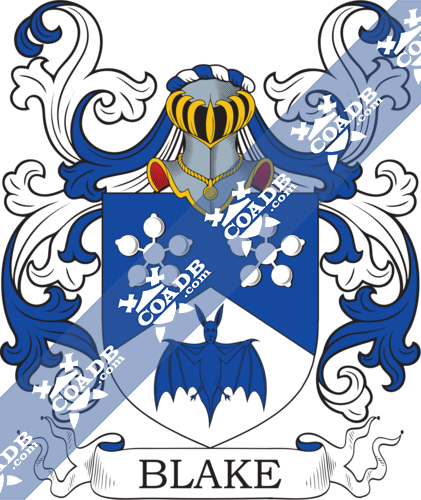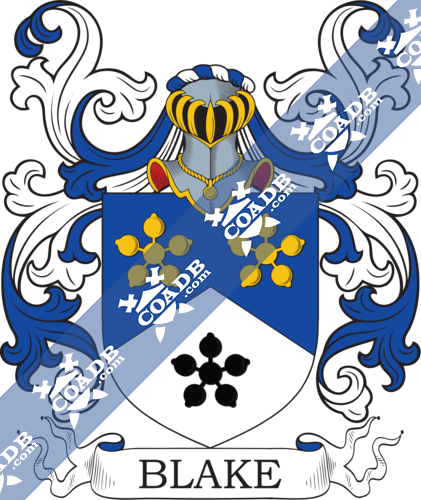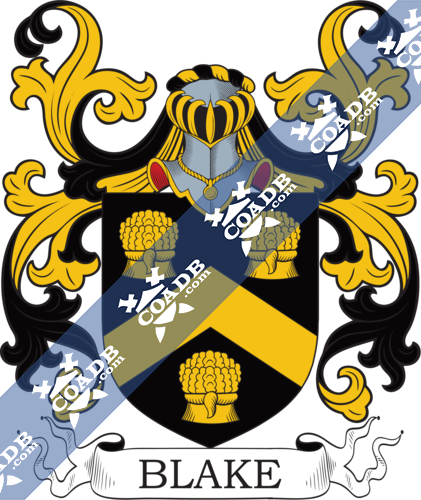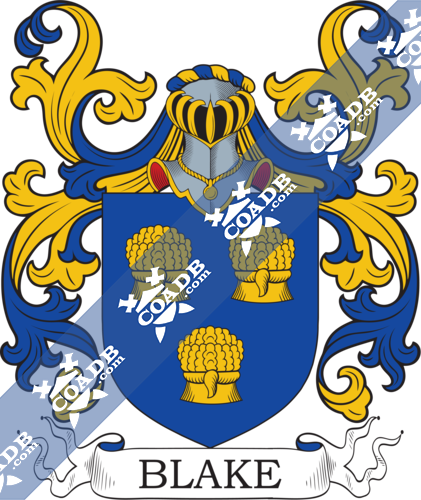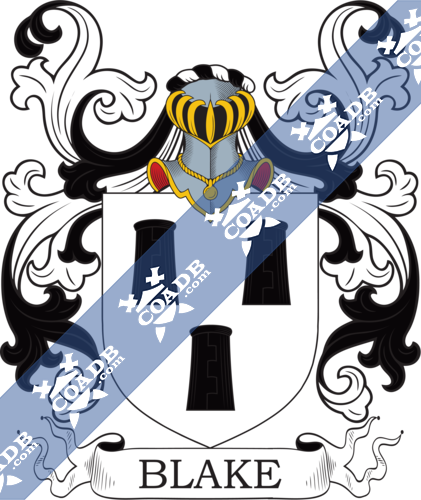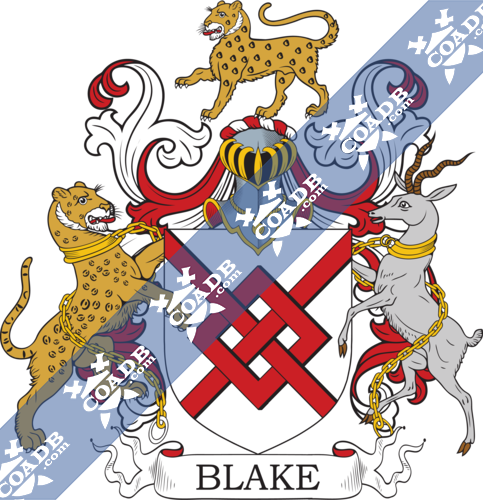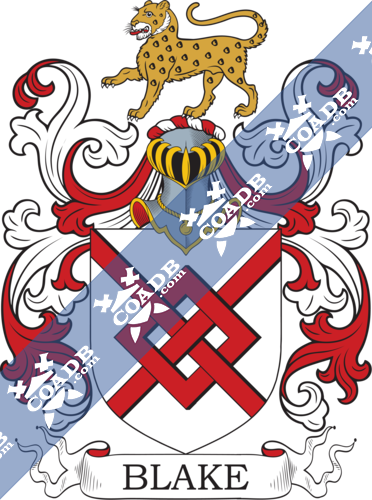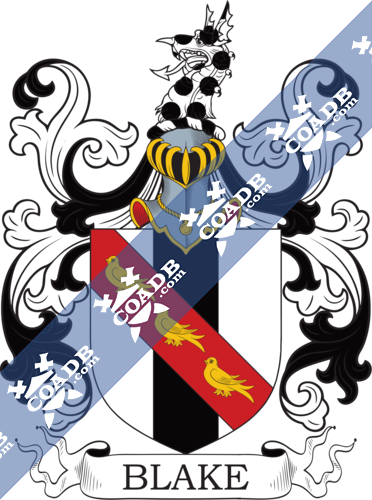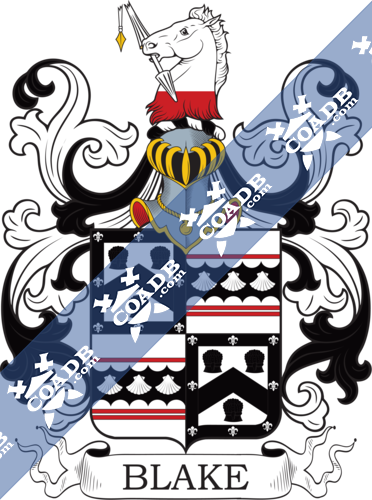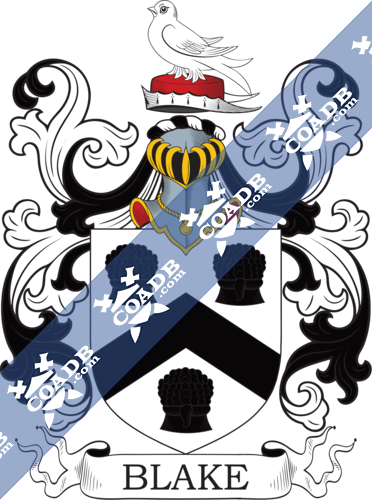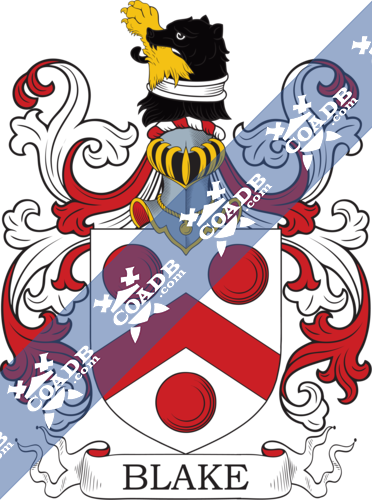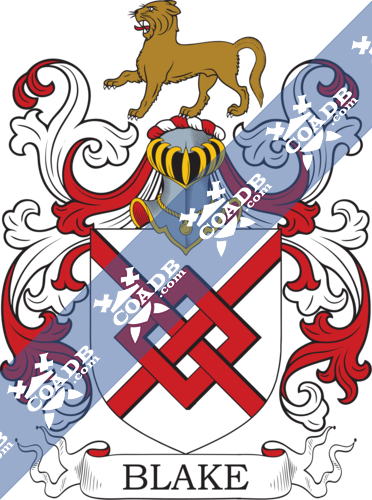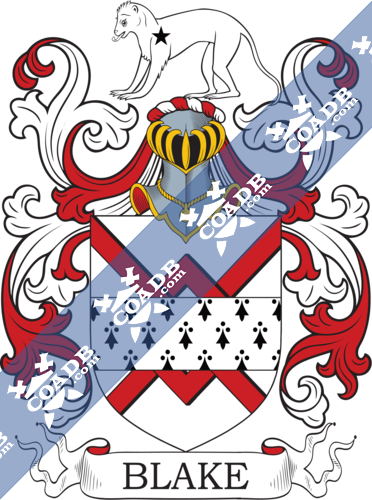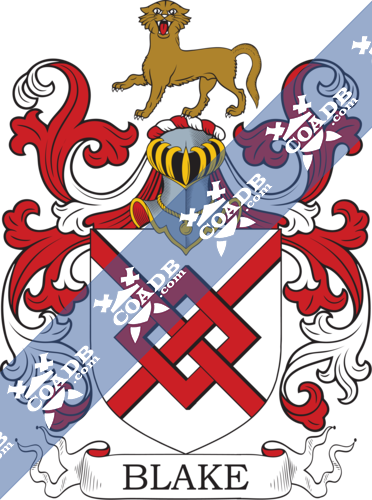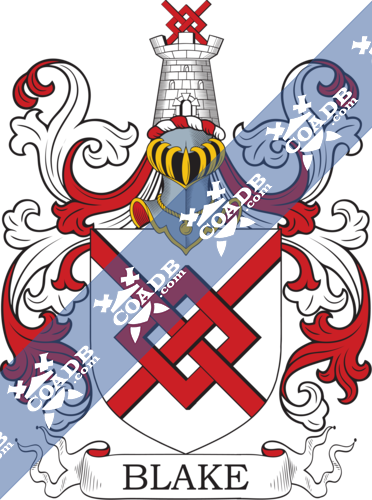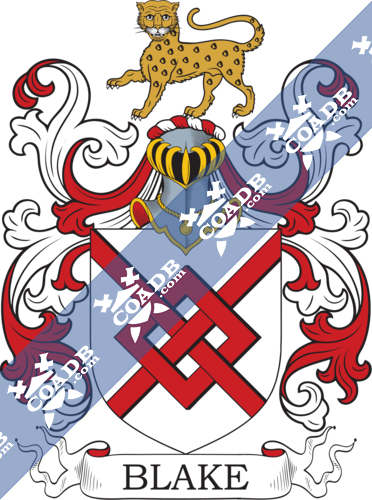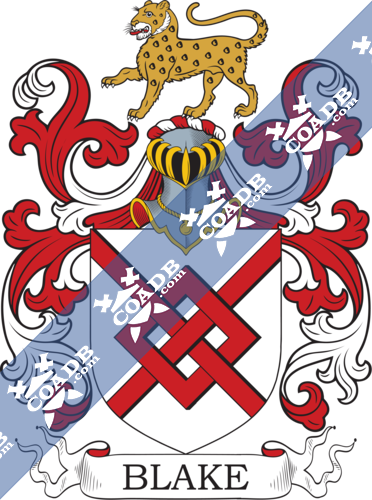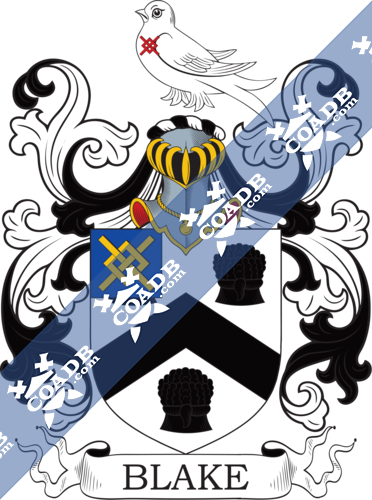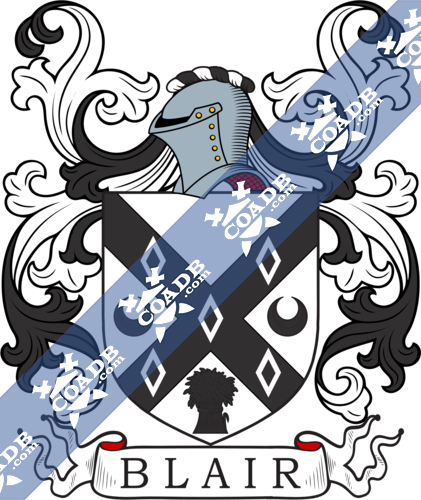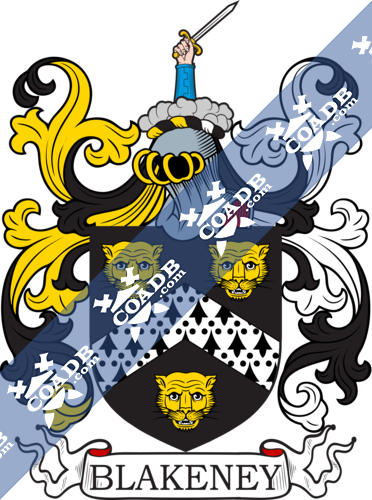Blake Family Crest, Coat of Arms and Name History
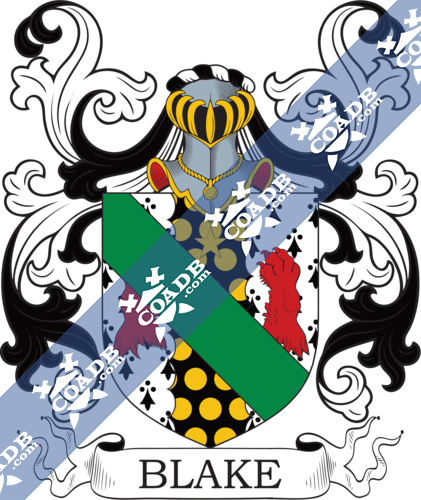
Blake Coat of Arms Gallery
Don’t know which Coat of Arms is yours?
We can do a genealogical research. Find out the exact history of your family!
Learn MoreBlake Surname Name Meaning, Origin, History, & Etymology
The popular last name Blake has six interesting origin theories. First, this name may be a spelling variant of the surname Black, meaning dark-haired or swarthy, deriving from the Old English or Anglo-Saxon adjective blaec or blac, meaning “black”. This may have been a name may have referred to the native members of the British Isles, the Celts, who had darker hair. Second, it may have derived as a nickname for a pale or fair complexion perfect, deriving from the Old English word blac, meaning “wan”, “pale”, “fair”, or white”. If this theory were accurate, it may have been a name given to Viking Invaders (Jutes, Angles, and Saxons) who had fairer features (pale skin and blonde hair). Third, some theorize that the name is a corruption of the British (or Welsh?) name Ap Lake, meaning “Son of Lake”. Fourth, in Ireland, it was an Anglicized form of the Gaelic surname O’Blathmhaic, meaning “descendant of Blathmhac”, a personal (first) name from the words blath (flower/blossom or fame/prosperity) and man (son). A fifth theory is the name be Old Norse in origin, first rising in Yorkshire, England, perhaps derived from the word Blaker, which was a village of Akerhus, Norway. In this theory it derives from the Old Norse word bleik. Sixth, one author states it derives from the personal (first) names Bleek and Blieck, which are Dutch and Flemish, respectively. It should be noted there was an medieval man Anglo-Saxon man known as “Wulfric se blaca”. It is also interesting to note that the name caught on as a given name, for both males and females, around the 1980s, particularly in the United States.
Blake was the name of one of the 14 Tribes of Galway in Ireland, which were powerful merchant families who dominated political, economic, and social life in the city in the Middle Ages through the late 1800s. Many members of this family descend from Richard Caddell, nicknamed le blac, who served as the Sheriff of Connacht, Ireland in the early 1300s, and was involved in the Norman Invasion of Ireland in 1169 AD. He was the son of Richard Caddell who was born around 1200 AD.
Spelling Variations
Some spelling variants or names with similar etymologies include Black, Bleak, Blakey, Blacke, Blakie, and Blaike. In Gaelic, the name is spelled de Blaca.
Popularity & Geographic Distribution
The last name Blake ranks 425th in popularity in the United Status as of the 2000 Census. The name ranks particularly high in the following four states: West Virginia, Vermont, New Hampshire, and Maine. The surname Blake frequency/commonness ranks as follows in the British Isles: England (233rd), Scotland (583rd), Wales (196th), Ireland (423rd) and Northern Ireland (1,042nd). In England, it ranks highest in counties Hampshire and Wiltshire. In Scotland, the surname ranks highest in Selkirkshire and Roxburghshire. In Wales, it ranks highest in Cardiganshire. In Ireland, it ranks highest in counties Meath and Clare. In Northern Ireland, it ranks highest in county Fermanagh. The name is also present throughout the remainder English speaking world: Canada (658th), New Zealand (343rd), Australia (277th), and South Africa (1,019th).
Henry Brougham Guppy’s 1890 book Homes of Family Names in Great Britain states the following in regard to this last name: “Amongst the old established Wiltshire families I may refer to that of Blake, which is at present best represented around Chippenham. There were Blakes in Warminster in the reign of Elizabeth, and they are still to be found there, and the name has been represented in Ludgershall since the beginning of the 17th century (H.). An influential family of this name owned Pinhill House in Calne in the 17th century” and “Blake is a south of England name, found most frequently in Wiltshire, Cornwall, Berkshire, and Oxfordshire. It was long known and is still found in Reading; the mayors of that town in 1683, 1710, and 1720 bore the name”.
In his book, A Topographical History of England, author Samuel Lewis writes “Twizell Castle, a fine though unfinished castellated mansion of the Blakes, is seated on a rocky precipice, surrounded by extremely picturesque scenry; and near it is Tillmouth House, the present residence of the family”.
Early Bearers of the Surname
The first known documented instance of the name is that of Walter le Blake who was listed in the Pipe Rolls of Devonshire, England in 1167 AD. The Hundred Rolls of 1273 AD, a census of Wales and England, known in Latin as Rotuli Hundredorum lists four bearer of this surname: Hamo le Blake (Buckinghamshire), Reginald le Blake (Cambridgeshire), Reyner le Blake (Norfolk), and Edericke le Blacke (Lincolsnire). Luce Blake was recorded as a tenant in Waldefgate, Berwick, Scotland around 1266 AD. Atkyn Blake was a charter witness in Syr, Scotland around 1340 AD. A one Thomas Blaik was a notary in Thornhill in 1627 AD. An early marriage involving this surname was Allin Blake to Dorothy Peregrine at St. George, Hanover Square in 1783.
Blake Family Tree & Blake Genealogy
The following is a discussion of ten different noble, royal, landed, or aristocratic families bearing this last name.
Blake of Danesbury
William Blake, Esquire of Danesbury, was a High Sheriff of Herts. In 1836, he married Mary, daughter of Joseph Nash, and had the following issue with her: William John, Frederick Rodolph (Colonel of the 33rd regiment, served in the Crimean War) married Henrietta Marten and had a son with him named Arthur), and Henry Wollaston (married Charlotte Anne Childers, had Lionel and others). His son William John was his heir and was born in 1805. He was a Member of Parliament for Newport and died in 1875. He was succeeded by his nephew. This nephew, Arthur-Maurice Blake, was an Esquire of Danesbury who was born in 1852. He was a Justice of the Peace and a Captain of the Grenadier Guards.
Blake-Humfrey of Wroxham
The genealogy of this family begins when this branch migrated from Wiltshire or Somersetshite to Bunwell, in county Norfolk, during the reign of King James I of England. They also resided at Scottow. Robert Blake was born in 1655, the son of John Blake of Bunewell, and he moved to Scottow where he built a sizeable mansion in 1680. He married Margaret, daughter of William Durrant. He left two sons upon his death: Robert (of Westwick) and Thomas. His son Thomas Blake was born in 1689. He married Elizabeth, daughter of John Jex of Lowestoft. He was succeeded by his eldest son, also named Thomas. This Thomas Blake was a Gentleman of Scottow and was born in 1726. He married Judith, daughter of William Clarke of Harleston, and had two sons with her: Thomas (his heir) and William (see Jex-Blake). His son and heir, Thomas, was an Esquire and Barrister-at-Law, of Scottow, as well as a Justice of the Peace and Deputy Lieutenant who was born in 1755. His second wife was Theodora-Martha, daughter of David Colombine of Norwich, and had the following issue with her: 1) Thomas (of Horstead), 2) Robert (of Wroxham), 3) Reverend Henry William (Rector of Thurning, had isseue named William, Anna Eliza, and Ellen Mary), 4) Francis John (of Norwich, married Sarah Norris, had daughters named Frances and Susanna Margaret), 5) Theodora Martha (married Reverend Robert Fountaine Elwin, had daughter named Mary A. Elwin), 6) Maria Margaret (married Reverend George Howes, Rector of Spexworth, had son named Frederick Howes), and 7) Judith Elizabeth. He died in 1813 and was succeeded by his eldest son Thomas. This Thomas was an Esquire of Horstead, Justice of the Peace, and Deputy Lieutenant who was born in 1790. He died in 1869 and was succeeded by his brother Robert. Robert Blake-Humfrey was an Esquire of Wroxham, county Norfolk, who was born in 1795. He was a Justice of the Peace, Deputy Lieutenant, and served in the Peninsular War as an officer under the Duke of Wellington. In 1847, by royal sign-manual, he obtained the additional surname and arms of Humfrey. In 1838, he married Charlotte, daughter of Lieutenant-Colonel Harvey, of Thorpe Lodge, near Norwich, and had the following children with her: Robert Harvey (Justice of the Peace, Barrister at Law, married Jane Charlotte Upeher, and had issue named Alwyne and Lillian Jane), Thomas, John (Reverend, Rector of Great Dunham, married Annie Carpenter), Margaret (married Harvey, son of John Ranking of Wandsworth Common), Eleanor (married Henry Lee Warner, son of Reverend James Lee-Warner), Caroline, and Isabel-Charlotte (married John Gurney of Sprouston). The Blake Coat of Arms of this branch of the family is blazoned in heraldry as follows: Argent, a chevron between three garbs sable, a bordure of the last charged with eight fleur-de-lis of the field. Crest: A morion, proper, thereon a martlet argent. Motto: Bene praeparatum pectus. They were seated at Heggatt Hall, Horstead, Norwich, and Wroxham, Norwich, England.
Jex-Blake of Swanton Abbotts
The lineage or genealogy of this family traces back to John Blake, a Gentleman of Bunwell, Norfolk, England, who was born in 1583. He married a woman named Martha, and had a son and heir with her also named John. This son John was born in 1622. He married twice: Anne (daughter of John Welles) and Susanna (daughter of John Stubling of Stoke). He had a son and heir named Robert. Robert Blake of Scottow was born at Bunwell in 1655. He married Margaret, daughter of William Durrant, and had issue with her, including a son named Thomas. This Thomas Blake was born in 1689. He married Elizabeth, daughter of John Jex of Lowestoft and Mary Coulson. They had a son together also named Thomas. This Thomas Blake was a Gentleman of Scottow who was born in 1726. In 1754, he married Judith, daughter of William Clarke of London, and had two sons with her: William (heir) and Thomas (of Norwich, Justice of the Peace and Deputy Lieutenant, married Theodora Columbine and had seven children with her). His son William was an Esquire of Swanton Abbotts, Justice of the Peace, and Deputy Lieutenant, who was born in 1758. He assumed the additional surname and arms of Jex upon his 1785 marriage to Catharine, daughter of Robert Ferrier, and had the following issue with her: William Jex (his heir), Reverend Robert Ferrier (Rector of Great Dunham, married Elinor Sarah Elizabeth Hoey), Thomas (of Cumberland Terrace, married twice and had issue), Judith, Catherine Charlotte, and Elizabeth (married Reverend John Gunton). The eldest son, Reverend William Jex Jex-Blake, of the Hall, was a Justice of the Peace born in 1786. In 1811, he married Maria, daughter of William Lubbock, and had the following issue with her: William Lubbock (discussed below), Charles Thomas (Rector of Lyng, married Fanny Johnson, and had issue named Thomas, Fanny-Helenia, Maria-Anna, Margaret Agnes Lubbock, Mary Richenda, and Charlotte Evelyn), Maria Catherine (married Reverend Townley Blackwood Price), and Anna Eliza (married W. Blackwood Price, had daughter named Anna). He died in 1857 and was succeeded by his son William. William Lubbock Jex Blake was an Esquire of The Hall, Swanton Abbots, county Norfolk, was a Justice of the Peace who was born in 1818. In 1847, he married Susan Margaret, daughter of Francis Blake, and had the following issue with her: William, Francis William (born 1850), Charles, Alice Catherine, Emma Mary, and Fanny Susanna. The Blake family crest is blazoned as follows: Quarterly: 1st and 4th, argent, a chevron between three garbs sable, within a bordure of the last, charged with eight fleur-de-lis of the field, for Blake; 2nd and 3rd, argent, on a fesse engrailed sable, between two plain cottises gules, three escallops of the field, for Jex. Crests: Blake: A morion proper, thereon a martlet argent; Jex: A horse’s head argent, maned or, erased gules, in the mouth a broken tilting-spear or. Motto: Bene praeparatum pectus.
Blake of Renvyle
The pedigree of this family begins with Richard Caddle, alias Blake, who was the Sheriff of Connaught in 1306 AD. He was the progenitor of many noble branches of the Blake family in Ireland, as well as two in England: including the Blake, Baronet of Langham, Suffolk, and Blake, Baronet of Twisel Castle, Durham. In 1315, he procured manors from Thomas Stobridge. He also received land grants during the reigns of King Edward I and Edward II. He had four sons, the eldest of which was Walter. Walter received a grant of the Customs of Galway. Walter had five sons. His eldest son was John Oge Blake. John married Margaret, daughter of Philip Le Brun, of Athenry. His great grandson was named Valentine. Valentine Blake married Julian, daughter of Geoffrey Lynch, with whom he had issue, including an heir named John. John married Eveline Skerret and had issue with her as follows: Nicholas, Richard, John Fitz John, and Julian. His eldest son, Nicholas, was the Mayor of Galway in 1555. His grandson was also named Nicholas. This grandson, Nicholas Blake, was also the Mayor of Galway, and he married Julian, daughter of Valentine French, and had a son with her named John. John was also Mayor of Galway (in 1646). He died in 1872and was succeeded by his son: Henry Edgar Valentine Blake, who was an Esquire of Renvyle, county Galway, Ireland, born in 1864. He married Mary French and had four sons as follows: Thomas (his successor), Henry, John (settled at Montserrat), and Nicholas (settled in Barbados). He also had a daughter named Katherine, who married Sir Robert Lynch. He was succeeded by his eldest son Thomas. This Thomas Blake was of Mullaghmore and Windfield. He married Mary, daughter of Nicholas Blake of Kiltullagh, and had a son with her named John. John was an Esquire of Windfield. John married Julian (oe Evelyn?), daughter of Alexander Lynch of Cloenernan, and had a son with her named Thomas. This son Thomas Blake was an Esquire of Windfield who married Anne, daughter of John Bodkin of Annagh, and had the following issue with her: John (his heir), Martin, Mark (of Renvyle, married Ms. French of Carcorea in Galway, had issue including Dominick, Valentine, John, and James). The eldest son, John, succeeded his father and married Mary Kirwan, but died without posterity. He was succeeded by his nephew, Valentine. Valentine Blake was an Esquire of Lehinch and Renvyle and Sheriff of Mayo. In 1788, he married Anna Maria, daughter of Reverend Richard Henry Roper, of Clones, and had the following issue with her: Henry, Marcus, Jane Maria, Caroline, and Julia Frances (married Reverend Henry Burke). He died in 1800 and was succeeded by his eldest son Henry. Henry Blake was an Esquire of Renvyle, as well as Justice of the Peace, who was born in 1789. In 1810, he married Martha-Louisa, daughter of Joseph Attersoll of Portland Place, and had the following issue with her: Edgar Henry (discussed more below), Harold Henry, Ethelbert Henry (Surgeon in the Royal Army, married Jane Caroline, Hay, had issue named Henry, Arthur Henry, William Henry, Robert, Edith Mary, Emma, Caroline Maria, Emilie Susette, Ethel Jane, and Eleanor Martha), Egbert Henry (died in shipwreck), Ethelred Henry, Ethelstane Henry (married Sophia Margarite, daughter of Jonis Gaudard of Lausanne, Switzerland, had issue named Herbert-Edgar, Egbert Mabere, and Ellen Margurite), Herbert Henry, Emelie Anna, and Eleanor Elizabeth. He died in 1856 and was succeeded by his son, Edgard Henry. This Edgar Henry Blake was an Esquire of Renvyle, Justice of the Peace, and Captain of the Royal Navy, who was born in 1814. In 1861, he married Caroline-Johanna, daughter of Reverend Henry A. Burke, and had the following children with her: Henry Edgar Valentine, Robert Attersoll, and Julia Emelia Martha. He died in 1872 and was succeeded by his son, Henry Edgar Valentine, who was born in 1864. The Blake coat of arms is blazoned in in the medieval European art of heraldry as follows: Argent, a fret gules. Crest: A mountain cat, passant, proper. Motto: Virtus sola and nobilitat. This family was seated at Renvyle, Letterfrack, Connemara, county Galway, Ireland.
Blake of Kiltullagh
This family descended from the Blakes of Renvyle. Richard Blake, Mayor of Gallway in 1533, son of John, acquired the Castle of Kiltullagh. John Fitz Richard succeeded his father’s property and was Mayor of Galway in 1578. In 1580, he married Julian Browne, and had a son named Nicholas Fitz John. In turn, Nicholas had a son named Anthony Fitz-Nicholas. Anthony in turn had a son named Nicholas Fitz Anthony who was an Alderman of Galway in 1639. He had a son named Patrick. This Patrick Blake had a son named Nicholas. Nicholas had a son named Patrick. This Patrick Blake, who lived in 1727, married Mary Browne, and had two sons with her: Thomas and Edward. Edward, his successor, was an Esquire who married Eliza Cheevers, and had the following children with her: Patrick, Mary, Honor, and Eliza. His eldest son Michael, was an Esquire who married Eliza Buller, and had the following issue with her: James, Michael, Patrick, Nicholas, Theresa, Mary Anne, and Henrietta. His eldest son, Edward, married Mary, daughter of Thomas McDermott, and had a son with her named Owen Edward. Owen Edward Blake was an Esquire of Kiltullagh who died in 1852 with issue. He was succeeded by his brother Theobald. Theobald Michael Blake was an Esquire of Kiltullagh and Frenchfort, county Galway, Ireland, as well as a Justice of the Peace and Deputy Lieutenant , born in 1829. In 1854, he married Elizabeth, daughter and heir of James Blake of Vermont, Galway, and had a son with her named Edward. This son Edward was born in 1855. The Blake family crest had the following heraldic blazon: Argent, a fret gules. Crest: A mountain cat, passant, proper. Motto: Virtus sola nobilitat. This Irish family was seated at Vermont, Glantane, Frenchfort and Kiltullagh, Oranmore, county Galway, Ireland.
Blake of Cregg Castle
This is a branch of the Blake of Renvyle. The progenitor was Nicholas Blake, an Esquire of the line of Blake of Kiltullagh. He was the father of Francis Blake. Francis married Julia Tierney, and had two sons with her: Henry and James. The son James was an Esquire of Cregg Castle, who in 1787, married Jane Joyce, and had issue with her as follows: Henry, Pierce, Walter, Francis, and Mary (married James MacDermott of Ramore). His son Francis Blake of Cregg Castle was a Justice of the Peace who was born in 1789. In 1819, he married Georgina, daughter of Rickard Burke of Glinsk, and had the following children with her: James (Cregg Castle), John (of Rockfield, Athenry, married Mary Anne Lynch-Staunton of Clydagh, had one son and two daughters), Henry, Rickard (of Annadown House), Francis, Jane (married Pierce Joyce of Merview), Johanna, Georgina (a nun), Fanny, and Mary. He died in 1869 and was succeeded by his son James. James Blake was an Esquire of Cregg Castle, county Galway, as well as a Justice of the Peace, who was born in 1822. In 1851, he married Helen Charlotte, daughter of Arthur French, and had two sons with her: Francis Arthur and Erroll. This family bore the same arms and crest as Blake of Kiltullagh. The Blake family motto was Virtus sola nobilitat. The family was seated at Cregg Castle, Galway, Ireland.
Blake of Towerhill
This branch of the family descended from the Blakes of Renvyle, starting with Thomas Blake, son of Valentine Blake and Juliana Lynch, who had a son named Walter. Walter had a son named Valentine. This Sir Valentine Blake, Baronet of Menlough, was so created in 1622. He first married Margaret, daughter of Roebuck French, with whom he had the following issue: Thomas (2nd Baronet), Francis (married Margaret, daughter of Patrick French, had daughters named Mary, Margaret, Katherine, Julian, Elizabeth, and Anne), Julian (married Adam Fonte), Margaret (married Sir Nicholas Arthur and later Theobald Butler), and Anne (married Richard Darcy).
Valentine O’Conor Blake was an Esquire of Towerhill in county Mayo and Bunown Castle in county Galway, Ireland, as well as Justice of the Peace, Deputy Lieutenant, and High Sheriff of Mayo. In 1836, he married Honorable Margaret Mary, daughter of Charles, and had the following children with her: Maurice (married Jeannette, daughter of Richard P. O’Reilly of Sans-Souci, Dublin, had issue with her), Charles, Valentine Joseph, Robert, Thomas, Martin Joseph, John Joseph, Mary, and Margaret. He died in 1634 and was succeeded by his eldest son Thomas. Sir Thomas Blake, 2nd Baronet of Menlough, married Julian, daughter of Geoffrey Browne, and had the following issue with her: Valentine (3rd Baronet), Walter (of Inxninge), Geoffrey, Francis, John, Moggine (married Joseph Lynch), Mary (Martin Kirwan), Margaret, Christian, Annabel, Anne, and Julian. He was succeeded by his eldest son, Valentine. Sir Valentine Blake, Baronet of Menlough, married Elinor, daughter of Sir Henry Lynch of Castle Carra, and had the following five issue with her: Thomas (4th Baronet), Henry (ancestor of the 9th baronet), Francis (of Carolina, had son named Joseph), John (of Cloneen), and Walter. He died in 1651 and was succeeded by his fourth son John. John Blake, Esquire of Cloneen, was an ardent supporter of King Charles II of England, and for this, he was gifted lands in counties Galway, Mayo, and Clare. He supported the Stuarts and died during the Besiege of Athlone in 1691. He left an only son named Isidore. Isidire married and had three sons: Maurice, Patrick, and John (of Arran Quay, Dublin). He was succeeded by his eldest son, Maurice Blake of Towerhill. Maurice married his cousin, Anne, daughter of Sir Walter Blake of Menlough Castle, and had two sons: Isidore and Anthony (of Rosslodge, married Katherine Burke of Keelogues). He was succeeded by his eldest son, Isidore. Isidore Blake was an Esquire of Oldhead and Towerhill, who married Fanny, daughter and co-heiress of Thomas Rutledge of Bushfield, and had six sons and four daughters as follows: 1) Maurice (discussed in more detail below), 2) Thomas (of Lakeview, married Margaret Dowell, had Isidore, Edward, Patrick, Fanny, and Elizabeth), 3) John (of Weston, married Charlotte Blake of Corbally, had son named Isidore John), 4) Peter (of Ballylahan, married Mary McLoughlin, had Isidore and other children), 5) Anthony (of Dublin, married Rebecca Skerrett and had a son named Joseph and a daughter), 6) Isidore (married Anne Coleman, had three daughters and sons named Isidore and Anthony), 7) Mary (married Arthur Lynch of Cloughballymore, had issue), 8) Anne (married Captain Joseph Bourke of Carrowkeel), 9) Catherine (married Daniel Jones of Banada, had one daughter), and 10) Fanny (married Arthur Lynch of Peterburgh, had a son named Charles Lynch). The eldest son, Maurice Blake, was an Esquire of Towerhill, Major of the North Mayo Militia, and Justice of the Peace. He married Maria, daughter of Valentine O’Connor of Dublin, and of Oakley Park, Blackrock, and had a son with her named Valentine O’Connor, and daughter named Mary (married the O’Conor Don), and Honoria (married Edward). The Blake Coat of Arms is blazoned as follows: Argent, a fret gules. Crest: A mountain cat, passant, proper. Motto: Virtus sola nobilitat. They were seated at Towerhill, Ballyglass and Bunown Castle, Clifden.
Blake of Ballinafad
The lineage of Blake genealogy of this branch traces back to Blake of Renvyle. This branch descended from William, the fifth son of Walter Blake. His descendant was Andrew Blake, a merchant if Galway, Irish. Andrew had a son named Walter. Walter had two sons: Robert (of Ardfry, ancestor of Blake, Lord Wallscourt, died 1616) and Walter. The son Walter had a son named Walter. This son Walter in turn had a son named Marcus. Marcus Blake was an Esquire of Galway and he had issue. His eldest son was Walter Blake. This Walter procured lands in county Mayo from David O’Kelly and other lands. He died in 1633 and was succeeded by his son Marcus Oge Blake who was born in 1629. Marcus Oge received regrants of his property by patent during the 33rd year of the reign of Charles II. He had a son named Maurice. This Maurice was an Esquire of Ballyfad. Maurice had a son named Mark. Mark Blake was an Esquire of Ballyfad. Mark had the following children: Austace, Walter, Mark (of Cloneen, had daughters of Katherine, Bridget, and Austance, and had sons named Maurice and John). The eldest son was Walter. Walter died without posterity and the estates went to his nephew Maurice. This Maurice Blake was an Esquire of Ballinafad who married Sibilla, daughter of Roebuck French of Dooras, and had four daughters with her as well as sons named Mark and Isidore Anthony. The elder son Mark was an Esquire of Ballinafad. He married Christian, daughter of Martin Kirwan of Blindwell, and had a daughter with her named Mary (married Andrew Browne of Moyvilla) and fours sons: Maurice, Martin, Mark, and Joseph. The eldest son, Maurice Blake, was an Esquire of Ballinafad, as well as High Sheriff of Mayo, Ireland. He married Anne, daughter and heiress of Arthur Lynch of Cloghballymore, and had the following issue with her: 1) Mark (of Ballinafad), 2) Maurice (Captain in the Army, married Margaret Wallis, had children named Maurice, Mark Joseph, Louisa), 3) Martin, 4) Joseph, 5), Llewellyn (Cloghballymore, Justice of Peace), 6) Mary (married George Henry Moore of Moore Hall, Member of Parliament), 7) Catherine (married Arthur O’Conor, Esquire and Justice of the Peace, of Palace Elphin, in Roscommon, Ireland), 8) Anna (married William Murphy of Mount Merrion), 9) Julia (married G.E. Browne of Brownestowne), and 10) Victoria (married twice, the second being Lieutenant Colonel Andrew Browne, later became Major General). The Blake family crest is blazoned as follows: Argent, a fret gules. Crest: A mountain cat, passant, proper. This Irish Blake family was seated at Ballinafad in county Mayo and Cloghballymore in county Galway.
Blake of Ballyglunin Park
This family descended from the Blakes of Renvyle and the House of Ardfry. Patrick Blake of Galway, son of Andrew, had a son named Andrew. Andrew was an Alderman who married Julia Matyn, and had the following issue with her: Walter (of Durramaerina, ancestor of Blake of that place and Oran Castle), Andrew, of Galway, Merchant, who got land grands, and was ancestor of Blake of Fartigar or Castle Grove, and Blake of Malaga in Spain), Martin, and Edward (a merchant in the Irish city of Galway). He died and was succeeded by his third son, Martin. This Martin Blake Fitz-Andrew was an Esquire of Cummer and High Sheriff of Galway. He had a grant of the estate of Ballyglunin during the reign of King Charles II of England. He married Margaret Martyn of Dangan, with who he had a daughter named Margaret (married Joseph Lynch, Esquire). He later married Anne Joyes, and had two sons with her: Peter (his heir), and Patrick (died in France in 1677). The elder son, Peter Blake, was an Esquire of Cummer and Ballyglunin, who married Sybilla Joyce, had two sons with her: Martin and Patrick (ancestor of Blake, Baronet of Langham). The elder son, Martin Blake, was an Esquire of Cummer and Ballyglunin, who in 1691, married Margaret, daughter of Edward French of Abbey Boyle, and had two issue with her: Sibilla (married Andrew Blake of Castlegrove) and Edmond. The son, Edmond, was an Esquire of Ballyglunin, who in 1724, married Mary French of Rahashane, and had the following issue with her: Mrs. Darcy of Hound’s Wood, and three sons: Martin (heir), John, and Reverend Robert. He died in 1771 and was succeeded by his eldest son Martin. This Martin Blake, Esquire of Ballyglunin, who in 1751, married Bridget, daughter of Pierce Joyce of Galway, and had five sons with her: Edmond (married Mary Aylward of Ballingar, had son named Martin Stephen), Walter, Martin, Reverend Pierce, and John (of Tuam, married Olivia Anna French, had issue named John Joseph and Julia). The second son, Walter, in 1789, married Mary Archdeacon, and had issue: Martin Joseph (heir), Henry (married Adelaide French, had issue named Walter Martin, Robert French, Henry, Martin, Captain 10th Regiment John O’Brien, Adelaide, Elizabetgh, Nichola, and Mary). The elder son, Martin Joseph Blake, was an Esquire, Deputy Lieutenant, and Member of Parliament. He died in 1861 and was succeeded by his nephew Walter. Walter Martin Blake was an Esquire of Ballyglunin, county Galway, Ireland, who was born in 1828. The Blake arms are blazoned in heraldry as follows: Argent, a fret gules. Crest: A mountain cat, passant guardant, proper. Motto: Virtus sola nobiltat. This Irish family was seated at Ballyglunin Park, county Galway, Ireland.
Blake of Tillmouth
The lineage of this family traces back to Francis Blake of Tillmouth Park, county Northumberland England, who was born in 1832 and became a Captain in the Northumberland Light Infantry Militia. He succeeded to said estate by devise of Sir Francis Blake, 3rd and last Baronet of Twisel. In 1853, he married Mary, daughter of Revered Roddam Douglas or Thornganby, and had three children with her: Sir Francis Douglas, Arthur Roddam Frederick (married Annie Moreton, daughter of Reverend E. Shortt) and Mary (born 1854). The eldest son, Sir Francis Douglas Blake, was a Justice of the Peace and Deputy Lieutenant who became the 1st Baronet. He was born in 1856. He was Lieutenant Colonel of the Northumberland Militia and a Member of Parliament. In 1886, he married Selina Colquhoun, daughter of James Cleland Burns of Glenlee, and had two sons with her as follows: Sir Francis Edward Colquhoun (2nd Baronet) and Patrick Delaval (married Phyllis, daughter of W. Lee Ellison of Vicars Cross, had issue named Ian Francis and Mary Douglas). He died in 1940 and was succeeded by his son Francis. Sir Francis Edward Colquhoun Blake, 2nd Baronet, of Tillmouth Park, Cornhill-on-Tweed, Northumberland, was a Captain of the Northumberland Hussars who was born in 1893. He married Olive Mary, daughter of Charles Liddell Simpson of Whiteside, and had the following issue with her: Francis Michael (born in 1943) and Pamela (served in World War II as a nurse, married Lieutenant Richard Olive Hosking and later Captain David Clayhills-Henderson and Invergowrie, Perth). He later married Doreen Maud, daughter of J. Betram Sample of Garden House. The coat of arms of this branch of the family is blazoned in heraldry as follows: Per chevron argent and sable a chevron per chevron between in chief two garbs and in base a fret all countercharged. Crest: A morion proper thereon a martlet argent holding in the beak a sprig of barley sable. Motto: Resurgam. This family was seated at Tillmouth Park, Cornhill-on-Tweed.
Blake of Langham
This family descends from Richard Caddell, who assumed the surname of Niger or Blake, and received a grant of the castle and lands of Kiltorroge, county Galway, Ireland in 1278 AD. M any generations down the Blake pedigree came one Patrick Blake, of St. Kitts in the West Indies, son of Peter of Cummer and Ballyglunin, who had sons himself. His eldest son was Andrew Blake, of St. Kitts and Montserrat. He married Marcella French and had issue with her. His eldest son was Sir Patrick Blake, 1st Baronet, of Langham, who was created a Baronet in October of 1772. He was a Member of Parliament for Sudbury, Suffolk, England, from 1768-1784. He married Annabella, daughter of Sir William Bunbury, Baronet, and had the following issue with her: Annabella (married Robert Jones Adeane of Babraham), Sir Patrick (2nd Baronet), and Sir James (3rd Baronet). He died in 1784 and was succeeded by his elder son, Sir Patrick Blake, 2nd Baronet, who was an officer in the 10th Dragons. In 1789, he married Maria Charlotte, daughter of James Phipps, of the island of St. Christopher, but he died without posterity in 1818, at which point the title devolved to his brother, James. Sir James Henry Blake, 3rd Baronet, in 1794, married Louisa Elizabeth, daughter of General Thomas Gage, and had numerous issue with her, including: Sir Henry Charles (4th Baronet), Admiral Patrick John of the Royal Navy, Reverend William Robert (Vicar of Great Barton, Suffolk), and James Bunbury (of Thurston House, married Catherine Pilkington, had a son named George who was a Captain in the 84th Regiment and was Colonel of the Suffolk Yeoman Cavalry). He died and was succeeded by his eldest son, Henry. Sir Henry Charles Blake, 4th Baronet, was born in 1794. In 1819, he married Mary Anne, daughter of William Whitter of Midhurst, and had the following issue with her: 1) Reverend Henry Bunbury (Rector of Hessett, married Frances Marian Oakes, had issue named Patrick James Graham, Marian Louisa, Emma Gage, Julia Porteus, and Mary Anne Thellusson), 2) William Gage (of Nowton Hall, married Mary bennet, had issue named Constance Gage, Evelyn Gage, and Henrietta Lillie Gage). He died in 1880 and was succeeded by his grandson, Patrick James. Sir Patrick James Graham Blake, 5th Baronet, was a Justice of the Peace and Lieutenant of the 3rd Bn. Suffolk Regiment who was born in 1861. In 1883, he married Emma Gertrude, daughter of Thomas Pilkington Dawson of Groton House, and had issue with her as follows: Cuthbert Patrick (see below) and Veronica (married Reverend Henry James Hensman, had issue). He died in 1930 and was succeeded by his son Cuthbert. Sir Cuthbert Patrick Blake, 6th Baronet, of Langham, Suffolk, England (in modern day United Kingdom) was born in 1855 and served in World War I as a Commander in the Royal Navy. In 1916, he married Florence Wilhelmina, daughter of Engr. Captain W.R. Apps, and had a daughter with her named Veronica Anstace. Veronica served in World War II as a nurse and was born in 1919. In 1942, she married Captain Hugh Gilson Taylor of the Suffolk Regiment, son of A.G. Taylor of Bamfield, and had children with him. The Blake Coat of Arms is blazoned as follows: Argent, a fret gules. Crest: A leopard, passant-guardant, proper. Motto: Confido in probltate. This family resided at The Grange, Little Waldingfield, Sudbury, Suffolk, England.
Blake of Menlough
Sir Ulick Temple Blake, the 16th Baronet of Menlough, county Galway, Ireland, was born in 1904. He was a 2nd Lieutenant of the 4th/7th Dragoon Guards and served in World War II. He succeeded his father in 1925. In 1940, he married Betty, daughter of Arthur Gordon of Blundellsands, and had issue with her as follows: Thomas Richard Valentine (born 1942). The lineage of this Blake genealogy or Blake ancestry traces back to Thomas Blake, Mayor of Galway in 1545 and in 1562, son of Valentine Blake (of the Blakes of Renvyle). He descended from Richard Caddle, called Niger. His eldest son was Walter Blake. The family arms is blazoned in heraldry as follows: Argent, a fret gules. Crest: A cat passant-guardant proper. Motto: Virtus sola nobiltat. This family was seated at Menlough, Galway. They resided at Saltergill, Yarm, Yorkshire, England.
Other Blake Pedigree & Family Trees
Jasper Blake, the nephew of Peter, was born in Norfolk, England in the late 1400s. He married Agnes Anne Pigot and later Anne Blonville. He had the following children: Henry, Peter, Eleanor, Thomas, Alice, and John. His son Peter was born in Wimbotsham, England around 1530. He married Beatrix Bachecroft and had four sons with her: Jasper, John, Francis, and Thomas. His son John Blake was born in the same town. He married three times: Mabel Coverte, Jane Rawson, and Jane Jugg. He had the following issue: Alice (Richards), Elizabeth, Anne (Saunders), Humphrey, William, Richard, Robert, and Giles Giles (Tweedy). His son William Blam Blake was born in Plainfield, Somerset, England in 1559. He married a woman named Anne and had a son with her named William. This son, William Blake II, was born in Pitminster, England in 1594. He married Agnes Thorn. He went to colonial America during, settling in New England. He had the following issue: George, John Thorne, William, James, and Edward. His son John Thorne Blake married Hannah Breck and later Mary Souther. He had a son named John as well. This John was born in 1640. He married a woman named Bridget and had sons named John and Robert. His son John was born in Wrentham, MA in 1664. He married Joanna Whiting and had two issue with her: James and Bridget (Jenks). His son James was born in the same town in 1689. He married Ann Bullard and they had a son named Moses. Moses Blake was born in the same area in 1726. He married Sible Fuller and had the following children with her: Josiah, David, David, and Simeon. His son Captain Simeon Blake was born in Rehoboth, MA in 1771. He served in General Anthony Wayne’s expedition against the Native Americans at the Battle of Fallen Timbers in Ohio. He married Lavina Peck and had the following issue with her: Sybil, Benjamin, Israel David, Mahala, Lavina, Lucinda (Ogle), and Francis. His son Israel David Blake was born in Marietta, Ohio around 1800. He married Elvira Clark and had a son with her named Joseph. This Joseph Blake was born in Morgan County, Ohio in 1833. He married Lucinda Wheeler and had numerous issue with her: Benjamin, Andrew, George Walter, Eli B., Anderson, Lydia, Elmore, Roselle, Grant, Leveretta, William, James W., John P., Frances E., Nellie, Oliver L., Richard I., Horace B., and others.
Humphrey Richard Blake was born in Plainfield, Somerset, England in 1494. He marries Agnes Littleton and had the following issue with her: John, Robert, Thomas, Agnes, Elenore, and Alice.
Early American and New World Settlers, Immigration Records
The book Genealogical Guide to the Early Settlers, mentions four bearers of this last name:
1) George Blake of Gloucester, 1640, was a selectman in 1644. He married a woman named Dorothy and had issue named Rebecca (1641), Deborah, Prudence, Elizabeth, Mary, Thomas (1658), and Ruth. He moved to Andover.
2) Joseph Blake of Hampton, who died in 1673. He had a wife named Deborah, and children named Timothy, Israel, John, Joshua, and Deborah.
3) John Blake of Middletown, Connecticut, who in 1673, married Sarah, daughter of Richard Hall, and had issue with her named Mercy, Sarah, Mary, Elizabeth, Abigail, John, Jonathan, Stephen, and Richard.
4) William Blake of Dorchester, Massachusetts who came aboard the Mary and John in 1630. He was the son of Giles of Little Baddon, county Essex, England, and brought with him William, James, John, Edward, and perhaps Ann. It was said he was a “useful” citizen and became a freeman and selectman in 1639.
Other settlers in colonial America bearing this surname include: William Blake came to Virginia aboard the Swan sometime between 1619-1622. Bartlomew Blake was recorded among the dead in James Cittie in 1624. Francis Blake, age 18, came to Virginia aboard the George in April 1635. John Blake came to Virginia aboard the Friendship of London in March 1636. Settler who came to the United States in the 1700s include: Charles Blake (Virginia 1702), Robert Blake (Virginia 1703), and Jane Blake (New England 1740).
In Canada, some of the first settlers of this family came to Nova Scotia in 1750, including William, John, and Iona Blake. In Australia, one of the first settlers bearing this last name was John Blake, a convict from Middlesex, England who came to New South Wales aboard the Asia in 1820. In 1831, another John Blake, a British convict from the island of Jamaica, came to Van Diemen’s Land (present day Tasmania) aboard the Argyle. In 1839, a family of this name came to the city of Adelaide aboard the Hooghly, including Jeremiah, Mary, and John Blake. In New Zealand, Richard Blake, a farmer aged 25, came to the city of Wellington in 1841 aboard the Catherine Stewart Forbes. Also, aboard this ship came Elizabeth Matilda Blake and Richard Blake, assumedly his wife and son, respectively.
Early Americans Bearing the Blake Family Crest
Charles Bolton’s American Armory (1927) contains two entries for this surname:
1) Argent a chevron between three garbs. Crest: On a chapeau gules turned up ermine a martlet sable.
2) Quarterly, 1st and 4th, argent a chevron between three garbs sable; 2nd, Sable a fess dancettee argent (or or?), and in chief three fleur-de-lis argent (Durant); and 3rd, Argent on a chief gules three cinquefoils of the field (Bellet of Quemberford). Crest: On a chapeau gules turned up ermine a martlet sable. Motto: Virtus sola nobilitat Bookplate George Baty Blake, Boston.
Matthew’s American Armoury and Bluebook (1907) discusses one bearer. William Phipps Blake of Mill Rock, Connecticut and Tucson, Artizona was born in New York City in 1826. He was the son of Elihu Blake of Worcester, Masschusetts and Adelaide Nancy (daughter of Captain Jonathan Phipps). Going back further, he was a descendant of Admiral Robert Blake, and also from James Phipps, Deputy Governor of Danforth, MA in 1622. He graduated from Yale University in 1852. He was involved in geology and mineralogy. In 1855, he married Charlotte Haven Lord, daughter of William Allen Hayes, and had the following children with her: William Phipps (1857), Francis Hayes (1860), Joseph Augustus (1864), Theodore Whitney (1866), Danforth Phipps (1874), and Constantia (married James William Toumey of Yale Forest School). Arms: Quarterly; 1st and 4th for Blake, argent, a chevron between three garbs sable, 2nd and 3rd for Phipps, sable, a trefoil within an orle of mullets argent. Crest: On a chapeau gules, turned up ermine, a martlet argent.
Crozier’s General Armory (1904) contains two entries for this surname:
1) Benjamin Blake of Plainsfield, South Carolina, 1682. Argent, a chevron between three garbs sable.
2) William Blake of Boston, MA in 1630, came from Somerset, England. Arms: Argent a chevron between three garbs sable. Crest: On a chapeau gules turned up ermine, a martlet sable.
Mottoes
I have identified two Blake family mottoes:
1) Virtus sola nobilitat (Virtue is the only nobility)
2) Bene praeparatum pectus (a well-prepared heart)
3) Coelestem spero coronam (I hope for a heavenly crown)
Grantees
We have 22 coats of arms for the Blake surname depicted here. These 22 blazons are from Bernard Burke’s book The General Armory of England, Ireland, and Scotland, which was published in 1848. The bottom of this page contains the blazons, and in many instances contains some historical, geographical, and genealogical about where coat of arms was found and who bore it. People with this last name that bore an Blake Coat of Arms (or mistakenly called the Blake Family Crest)
1) Mary Blake, daughter of William of Andover, Wiltshire, England, and wife of Ralph Rigges of Farnham, Surrey, by Segar 1610
Notables
There are hundreds of notable people with the Blake surname. This page will mention a handful. Famous people with this last name include: 1) Anthony Richard Blake (1786-1849) who was an Irish lawyer, administrator, and “backstairs Viceroy of Ireland”, 2) William Blake (1757-1827) who was an English poet and painter born in Soho, London, England, considered one of the greatest Britons of all time, 3) William Casey Blake (1973) who was an American former professional baseball player in the MLB who played from 1999-2011 for several different teams including the Cleveland Indians, having been born in Des Moines, Iowa, 4) Major General David Valentines Jardine Blake (1887-1965) who was a senior commander in the Australian Army who served in both world wars, born in Parramatta, New South Wales, 5) Dominick Edward Blake (1833-1912) who was the 2ND Premier of Ontario, Canada from 1871-1872, 6) Sir Ernest Edward Blake (1845-1920) who was a British colonial officer born in Norfolk, England who served as Crown Agent for the Colonial from 1881-1909, 7) Gordon Aylesworth Blake (1910-1977) who was a US Air Force lieutenant general who served in World War II and later as the director of the National Security Agency, having been born in Charles City, Iowa, 8) George Alexander Hamilton Blake (1810-1884) who was a American Cavalry officer who served in the Indian Wars, Mexican-American War, and the American Civil War, born in Philadelphia, Pennsylvania, 9) Joseph Hector “Toe” Blake (1912-1995) who was a Canadian Hockey player and coach in the NHL who was associated with the Montreal Canadians, born in Victoria Mines, Ontario, and 10) Robert Bowlby Blake (1969) who was an ice hockey player from Simcoe, Ontario, Canada, who played in the NHL from 1988 to 2010 for three different teams: Los Angeles Kings, Colorado Avalanche, and San Jose Sharks.
Blazons & Genealogy Notes
1) (Ireland, founded by Richard Blake, who came to Ireland with Prince John, 1185, afterwards King John, and got grants of land in cos. Galway and Mayo). Ar. a fret gu. Crest—A leopard pass. ppr.
2) (Baron Wallscourt, representative of the Blakes of Ardfry). Ar. a fret gu. Crest—A leopard pass. ppr. Supporters—On the dexter side a leopard, on the sinister an antelope, both collared and chained or. Motto—Virtus sola nobilitat.
3) (Menlough, co. Galway, bart., registered to Sir Thomas Blake, of Galway, 1st bart.). Ar. a fret gu. over all a fess erm. Crest—A monkey statant ar. charged on the shoulder with a mullet sa.
4) (Menlough, co. Galway, bart., descended from Sir Valentine Blake Fitzwalter Fitzthomas, Mayor of Galway in 1611 and 1630, created a baronet of Ireland in 1622). Ar. a fret gu. Crest—A cat pass. guard. ppr. Motto—Virtus sola nobilitat.
5) (Furbough, co. Galway. The same Arms and Motto as Baron Wallscourt. Crest—A mountain cat pass. guard. ppr. (Kiltullagh and Frenchfort, co. Galway). (Merlinstown, co. Mayo). (Leyhinch, co. Galway). (Ballyglunnin Park, co. Galway). (Cregg Castle, co. Galway). (Renvyle, co Galway). (Windfield, co. Galway). (Ballinafad, co. Mayo). (Ballinafad, co. Mayo). (Tower Hill, co. Mayo).
6) (co. Galway. Smith’s Ordinary). Same Arms. Crest—On a tower ar. a fret gu.
7) (granted to Robert Blake Blake, Esq., of Knockmoy, co. Galway, on changing his name from Foster, 1847). Same Arms. Crest—A leopard pass. guard. ppr. Motto—Virtus sola nobilitat.
8) (Langham, co. Suffolk, bart.). Same Arms. Crest—A leopard pass. ppr.
9) (Twisel House, co. Durham, bart.). Ar. a chev. betw. three garbs sa. on a canton az. a fret or. Crest—A martlet ar. charged on the breast with a fret gu.
10) (Essex). Ar. a pale sa. over all a bend gu. charged with three martlets or. Crest—A dragon’s head erased ar. pellettee.
11) (Swaffham, co. Norfolk). Erm. on a pale engr. sa. bezantee betw. two lions’ paws erect and erased gu. a mullet or. over all a bend vert.
12) (Wimbotsham, co. Norfolk). Erm. a pile embattled, counter-embattled sa. bezantte betw. two lions’ paws erect and erased gu. over all a bend vert.
13) (Horstead, Norfolk, formerly of Bunwell and Scottow, in the same co.). Quarterly, 1st and 4th, ar. a chev. betw. three garbs sa. within a bordure of the second, charged with eight fleurs-de-lis of the field; 2nd and 3rd, ar. on a fesse engr. as betw. three plain cottises gu. three escallops of the field. Crest—On a morion ppr. a martlet ar. Motto—Bene praeparatum pectus.
14) (Jex-Blake, Swanton Abbott, co. Norfolk). Same Arms. Crest of Jex—A horse’s head ar. erased gu. Holding in his mouth a broken tilting spear of the first headed gold. Motto—Bene praeparatum pectus.
15) (Wiltshire). (Visit. co. Cornwall, 1620). (as borne by the celebrated Admiral Blake, who was b. at Bridgewater in 1599, and d. in 1657). Ar. a chev. betw. three garbs sa. Crest—On a chapeau gu. turned up erm. a martlet ar.
16) Ar. a chev. gu. betw. three torteaux. Crest—A bear’s head sa. gorged with a collar ar. holding in the mouth a lion’s gamb erased or.
17) Per chev. az. and ar. in chief two cinquefoils of the second, and in base a bat displ. of the first.
18) Per chev. az. and ar. two cinquefoils in chief or, and one in base sa.
19) Sa. a chev. betw. three garbs or.
20) Az. three garbs or.
21) or Bleak – Ar. three sleeves erect sa.
22) (Ballinacourty and Kilmeadon, co. Waterford, a branch of Blake of Renvyle, co. Galway, descended from Richard Caddell, alias Blake, Sheriff of Connaught, a.d. 1306. The present John Aloysius Blake, Esq., of Ballinacourty and Kilmeadon, is M.P. for co. Waterford). Ar. a fret gu. Crest—A cat-a-mountain pass. ppr. Motto—Virtus sola nobilitat.


